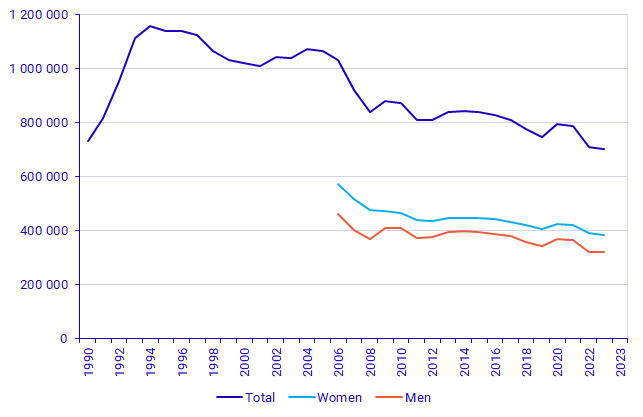Number of full-year persons receiving social assistance and benefits 2023
Number of persons receiving economic support continues to decrease
Statistical news from Statistics Sweden 2024-03-22 8.00
The number of full-year persons receiving economic support in the form of social assistance and benefits decreased by 1.2 percent in 2023. The total number in 2023 was 701 953 people, the lowest level since the start of the survey, which corresponds to 11.8 percent of the working age population. The greatest decrease in full-year persons was accounted for by economic aid, 12.3 percent, while sickness benefits accounted for the largest increase, 4.8 percent since 2022.
Statistics Sweden annually reports statistics on the number of full-year persons aged 20–64 who receive economic support in the form of social assistance and benefits. These comprise sickness benefits, sickness or activity compensation, unemployment benefits, labour market policy measures, economic aid, and introduction benefit.
Different types of benefits can be made comparable by using ‘full-year equivalents’, that shows how many individuals could be supported during an entire year on full benefits. For example, two persons who have both been unemployed full-time for six months together amount to one full-year equivalent.

The number of full-year equivalents receiving social assistance and benefits rose by almost 60 percent between 1990 and 1994. Since then, the figure has dropped steadily, and in 2019 it was almost at the same level as in 1990. Between 2019 and 2020, the number of full-year equivalents of unemployment benefits and labour market programmes increased sharply due to the pandemic. The higher level remained in 2021, to then decrease in 2022 and 2023 to the lowest levels since the start of the survey.
In 2023, the number supported by economic aid, introduction benefit, labour market programmes and sickness or activity compensation decreased, while there was an increase in unemployment benefits and sickness benefits.
Sickness and activity compensation, which is the largest form of compensation, accounted for about 29.3 percent of the total number of full-year equivalents, has decreased since 2006. In 2023, this form decreased by 1.3 percent and has thus decreased by 55 percent since 2006.
Introduction benefit was introduced in 2011 and the number of full-year equivalents for this form of compensation increased sharply until 2017. However, in the last years this number has decreased sharply; in 2023 it decreased by 3.3 percent.
The form of compensation that increased the most in 2023 was sickness benefits, which increased by 4.8 percent.
| Type of compensation | Number of full-year equivalents | Share of total full-year persons | Share of working-age population | Change in percent 2023/2022 |
|---|---|---|---|---|
| Sickness benefits | 167 503 | 23.9 | 2.8 | 4.8 |
| Sickness or activity compensation | 205 807 | 29.3 | 3.5 | ‑1.3 |
| Unemployment benefits | 69 411 | 9.9 | 1.2 | 3.3 |
| Labour market programmes | 177 839 | 25.3 | 3,0 | ‑2.8 |
| Economic aid | 71 502 | 10.2 | 1.2 | ‑12.3 |
| Introduction benefit | 9 892 | 1.4 | 0.2 | ‑3.3 |
| Total | 701 953 | 100,0 | 11.8 | ‑1.2 |
Statistical Database
More information is available in the Statistical Database
Feel free to use the facts from this statistical news but remember to state Source: Statistics Sweden.
